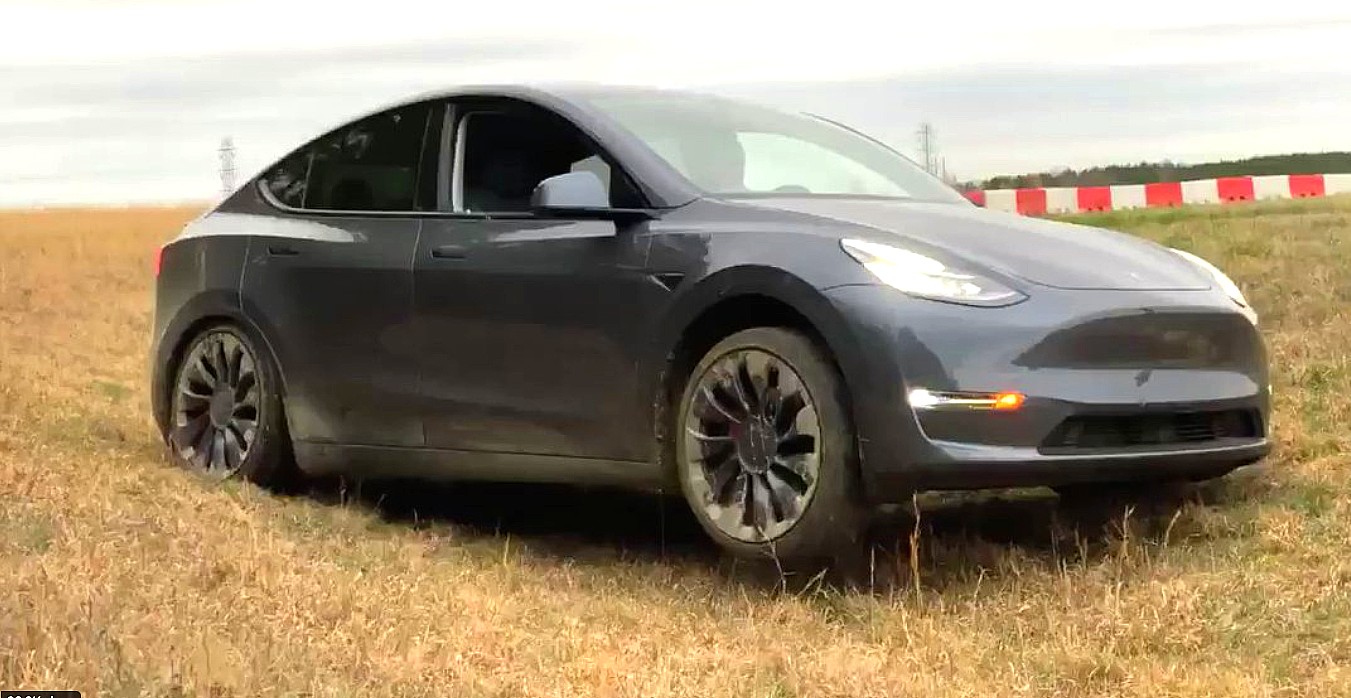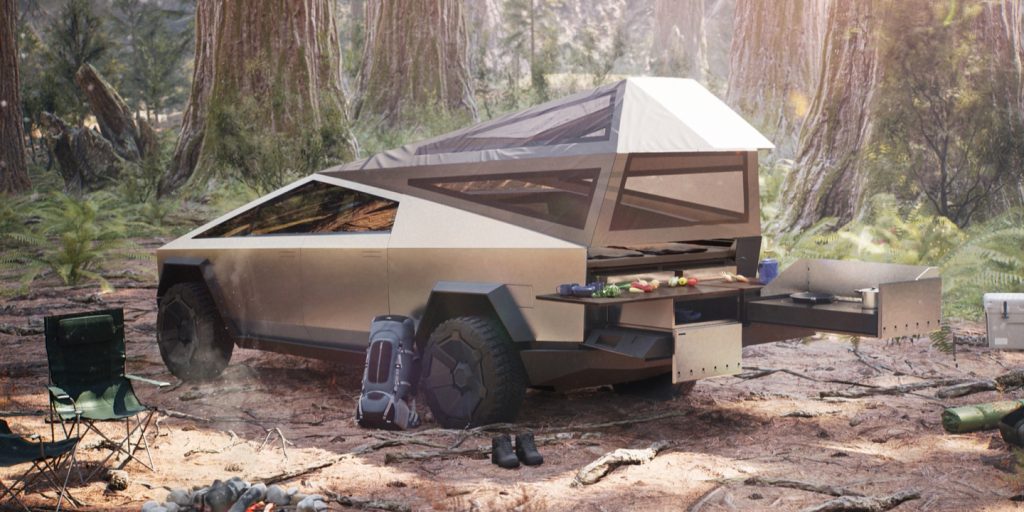

News
Tesla Model Y ‘off-road’ assist test bodes well for Cybertruck’s overlanding abilities
The Model Y is pretty unique in the way that it is the only Tesla today with a dedicated “Off-Road Assist” mode. This feature, despite being more of a side function for the Model Y, bodes very well for the Cybertruck’s off-road and overlanding capabilities.
The Tesla Model Y’s design gives the impression that the vehicle is designed for the city, and this is no more emphasized in the Performance variant, which sits low on the ground with large 21″ Überturbine Wheels. The Model Y Performance is built for quickness and handling, but if a recent video is any indication, even such a vehicle can hint at some of Tesla’s off-road tech that is currently in development.
The Out of Spec Motoring group recently managed to get their hands on a brand new Model Y Performance, thanks to owner-enthusiast Brian of the i1Tesla YouTube channel. The motoring group tested the Model Y’s track capabilities, and they came away impressed at the vehicle’s driving dynamics. But in a recent tweet, the group also demonstrated how Tesla’s Off-Road Assist feature worked on the Model Y.
The test was brief, and the location of the run was only the uneven, grassy outskirts of the North Carolina Center for Automotive Research track. But even in the quick test, it was evident that the Model Y’s “off-road” assist feature performed quite a bit better than the AWD systems used by Tesla in its previous vehicles, like the Model X and the Dual Motor Model 3.
The group, for one, opted to check how the Model Y handles a situation where some of its tires are off the ground, compromising its traction. Based on the short clip, the all-electric crossover did not seem to have any problems sending power to the correct wheels. This allowed the Model Y to navigate the uneven terrain without any difficulty.
While critics would be quick to point out that Out of Spec Motoring‘s Model Y off-road test only provided a slight strain on the all-electric crossover’s systems, it should be noted that the vehicle will likely provide Tesla with valuable data that could then be used for the company’s upcoming vehicles like the Cybertruck.

Unlike the Model Y, the Cybertruck is designed as a true rough-and-tough vehicle, and it would require a dedicated off-road assist feature that’s enough to match or perhaps even shame industry leaders such as Jeep and land Rover. This is especially true if Tesla were to target the overlanding market, a community of buyers that prioritize vehicles that can handle the elements for extended periods of time.
The Model Y’s Off-Road Assist feature will likely be used for the most part to traverse terrain much like the one used by Out of Spec Motoring in its brief test. Yet the feature could very well turn out to be the next Track Mode, a capability that will likely allow the company’s flagship vehicles to dominate on the closed circuit when they get released. While the Model 3’s Track Mode would likely enable the next-gen Roadster to outclass other supercars, the Model Y’s off-road assist would likely pave the way for the Cybertruck’s disruption of the pickup truck market.

Elon Musk
Elon Musk and Tesla AI Director share insights after empty driver seat Robotaxi rides
The executives’ unoccupied tests hint at the rapid progress of Tesla’s unsupervised Robotaxi efforts.

Tesla CEO Elon Musk and AI Director Ashok Elluswamy celebrated Christmas Eve by sharing personal experiences with Robotaxi vehicles that had no safety monitor or occupant in the driver’s seat. Musk described the system’s “perfect driving” around Austin, while Elluswamy posted video from the back seat, calling it “an amazing experience.”
The executives’ unoccupied tests hint at the rapid progress of Tesla’s unsupervised Robotaxi efforts.
Elon and Ashok’s firsthand Robotaxi insights
Prior to Musk and the Tesla AI Director’s posts, sightings of unmanned Teslas navigating public roads were widely shared on social media. One such vehicle was spotted in Austin, Texas, which Elon Musk acknowleged by stating that “Testing is underway with no occupants in the car.”
Based on his Christmas Eve post, Musk seemed to have tested an unmanned Tesla himself. “A Tesla with no safety monitor in the car and me sitting in the passenger seat took me all around Austin on Sunday with perfect driving,” Musk wrote in his post.
Elluswamy responded with a 2-minute video showing himself in the rear of an unmanned Tesla. The video featured the vehicle’s empty front seats, as well as its smooth handling through real-world traffic. He captioned his video with the words, “It’s an amazing experience!”
Towards Unsupervised operations
During an xAI Hackathon earlier this month, Elon Musk mentioned that Tesla owed be removing Safety Monitors from its Robotaxis in Austin in just three weeks. “Unsupervised is pretty much solved at this point. So there will be Tesla Robotaxis operating in Austin with no one in them. Not even anyone in the passenger seat in about three weeks,” he said. Musk echoed similar estimates at the 2025 Annual Shareholder Meeting and the Q3 2025 earnings call.
Considering the insights that were posted Musk and Elluswamy, it does appear that Tesla is working hard towards operating its Robotaxis with no safety monitors. This is quite impressive considering that the service was launched just earlier this year.
Elon Musk
Starlink passes 9 million active customers just weeks after hitting 8 million
The milestone highlights the accelerating growth of Starlink, which has now been adding over 20,000 new users per day.

SpaceX’s Starlink satellite internet service has continued its rapid global expansion, surpassing 9 million active customers just weeks after crossing the 8 million mark.
The milestone highlights the accelerating growth of Starlink, which has now been adding over 20,000 new users per day.
9 million customers
In a post on X, SpaceX stated that Starlink now serves over 9 million active users across 155 countries, territories, and markets. The company reached 8 million customers in early November, meaning it added roughly 1 million subscribers in under seven weeks, or about 21,275 new users on average per day.
“Starlink is connecting more than 9M active customers with high-speed internet across 155 countries, territories, and many other markets,” Starlink wrote in a post on its official X account. SpaceX President Gwynne Shotwell also celebrated the milestone on X. “A huge thank you to all of our customers and congrats to the Starlink team for such an incredible product,” she wrote.
That growth rate reflects both rising demand for broadband in underserved regions and Starlink’s expanding satellite constellation, which now includes more than 9,000 low-Earth-orbit satellites designed to deliver high-speed, low-latency internet worldwide.
Starlink’s momentum
Starlink’s momentum has been building up. SpaceX reported 4.6 million Starlink customers in December 2024, followed by 7 million by August 2025, and 8 million customers in November. Independent data also suggests Starlink usage is rising sharply, with Cloudflare reporting that global web traffic from Starlink users more than doubled in 2025, as noted in an Insider report.
Starlink’s momentum is increasingly tied to SpaceX’s broader financial outlook. Elon Musk has said the satellite network is “by far” the company’s largest revenue driver, and reports suggest SpaceX may be positioning itself for an initial public offering as soon as next year, with valuations estimated as high as $1.5 trillion. Musk has also suggested in the past that Starlink could have its own IPO in the future.
News
NVIDIA Director of Robotics: Tesla FSD v14 is the first AI to pass the “Physical Turing Test”
After testing FSD v14, Fan stated that his experience with FSD felt magical at first, but it soon started to feel like a routine.

NVIDIA Director of Robotics Jim Fan has praised Tesla’s Full Self-Driving (Supervised) v14 as the first AI to pass what he described as a “Physical Turing Test.”
After testing FSD v14, Fan stated that his experience with FSD felt magical at first, but it soon started to feel like a routine. And just like smartphones today, removing it now would “actively hurt.”
Jim Fan’s hands-on FSD v14 impressions
Fan, a leading researcher in embodied AI who is currently solving Physical AI at NVIDIA and spearheading the company’s Project GR00T initiative, noted that he actually was late to the Tesla game. He was, however, one of the first to try out FSD v14.
“I was very late to own a Tesla but among the earliest to try out FSD v14. It’s perhaps the first time I experience an AI that passes the Physical Turing Test: after a long day at work, you press a button, lay back, and couldn’t tell if a neural net or a human drove you home,” Fan wrote in a post on X.
Fan added: “Despite knowing exactly how robot learning works, I still find it magical watching the steering wheel turn by itself. First it feels surreal, next it becomes routine. Then, like the smartphone, taking it away actively hurts. This is how humanity gets rewired and glued to god-like technologies.”
The Physical Turing Test
The original Turing Test was conceived by Alan Turing in 1950, and it was aimed at determining if a machine could exhibit behavior that is equivalent to or indistinguishable from a human. By focusing on text-based conversations, the original Turing Test set a high bar for natural language processing and machine learning.
This test has been passed by today’s large language models. However, the capability to converse in a humanlike manner is a completely different challenge from performing real-world problem-solving or physical interactions. Thus, Fan introduced the Physical Turing Test, which challenges AI systems to demonstrate intelligence through physical actions.
Based on Fan’s comments, Tesla has demonstrated these intelligent physical actions with FSD v14. Elon Musk agreed with the NVIDIA executive, stating in a post on X that with FSD v14, “you can sense the sentience maturing.” Musk also praised Tesla AI, calling it the best “real-world AI” today.








